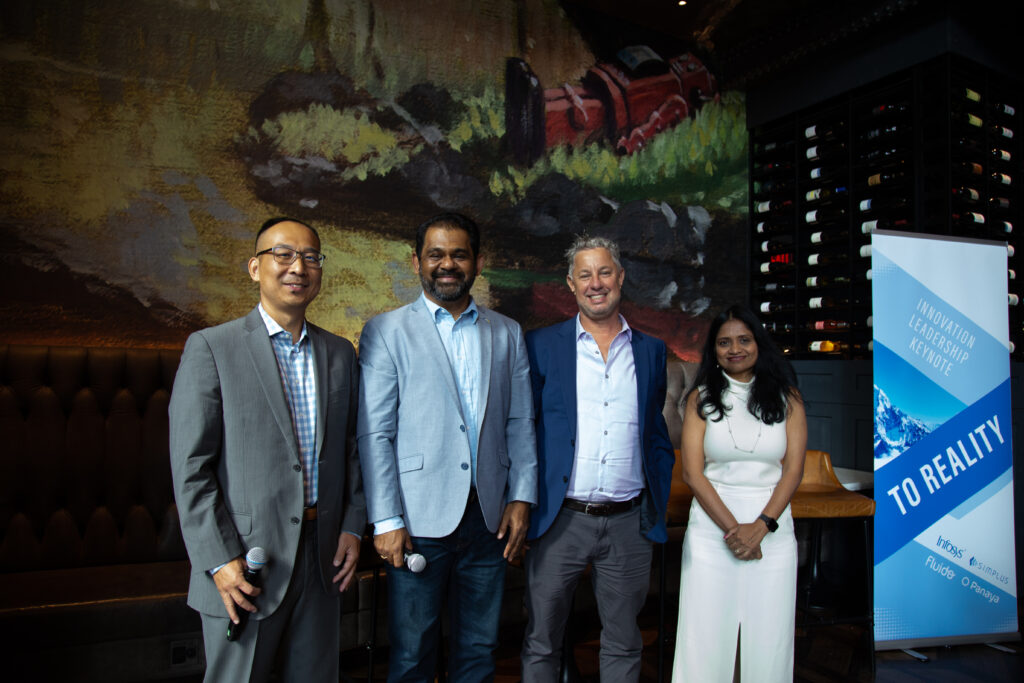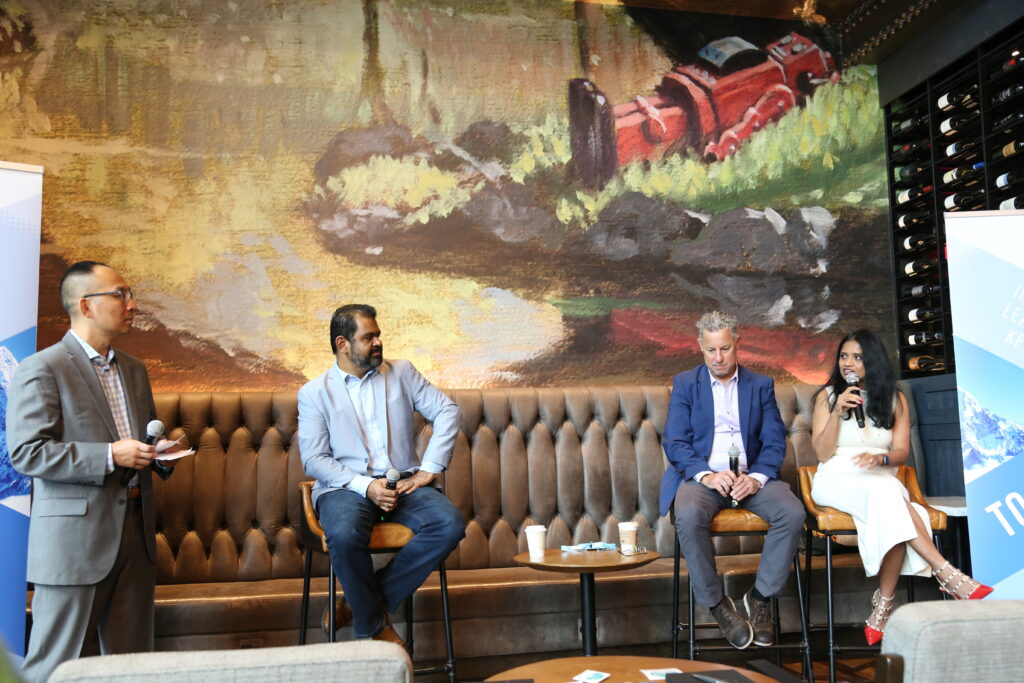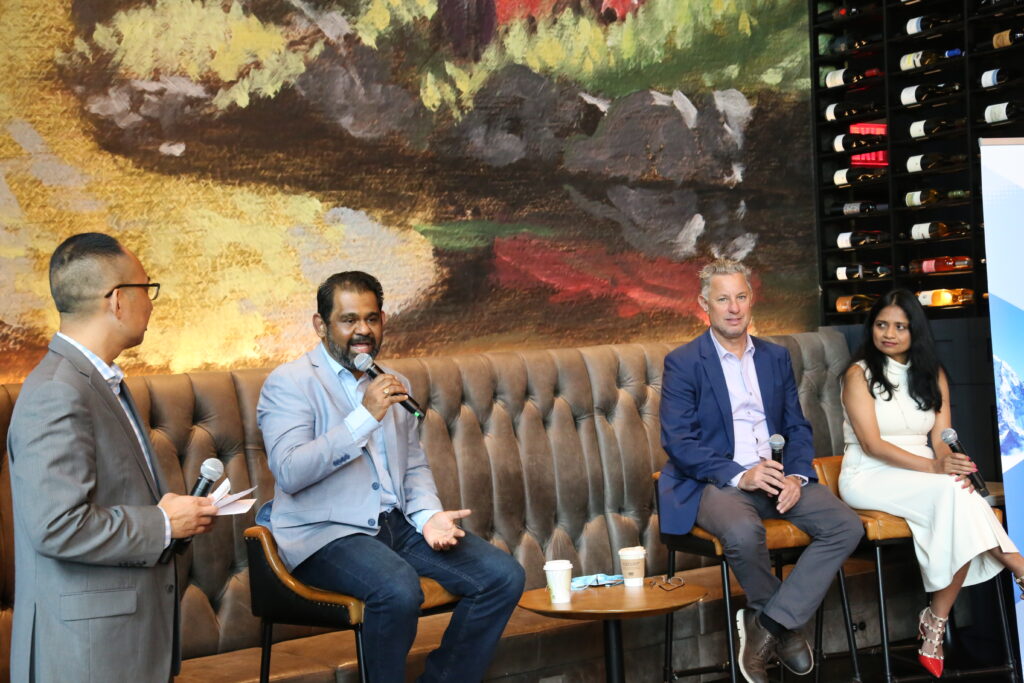Today’s business landscape is fast-paced and ever-evolving, and the role of AI and digital innovation has never been more pivotal. In this dynamic environment, embracing these innovations isn’t merely an option; it’s a strategic imperative for companies looking to remain competitive, agile, and relevant.
During this Dreamforce 2023 Keynote Innovation Panel, Steve Seo, VP of Sales at Simplus, discussed practical experiences with innovation with leaders from some of today’s most expansive companies.
According to Mari Shankar, EVP at Telarus, Ramya Raj, VP & Global Head of Go-To Customer Solutions at Genesys, and Avi Rosenfeld, General Manager, ForeSight Line of Business at Panaya, these innovations have not only disrupted established industries but have also created entirely new ones. They agree that companies that are quick to adapt and harness the power of these AI-backed digital tools gain a distinct competitive advantage, while those that lag behind risk becoming obsolete.
Although they admit digital transformation is a work in progress, the strategies shared by these participants offer direction for other B2B or B2C companies to effectively address business goals and establish expectations that redefine innovation with a renewed focus on the user experience from within their infrastructure while extending out to customers.
Their decision to implement AI-supported innovation also illustrates the need to partner with an experienced advisory team, capable of customizing a system that offers simplified day-to-day solutions.
In this article, we’ll highlight portions of this keynote panel discussion about the essential steps every company must face with digital transformation, and show how the approach adopted by these three leaders, and their decision to implement Salesforce AI-backed products, has made a tremendous impact on their success.

Identify Business Goals and Challenges
Identifying business goals and challenges provides the essential foundation for a successful digital transformation journey. It ensures that the transformation efforts are purpose-driven, well-focused, and capable of delivering tangible benefits to the organization while minimizing risks and optimizing resource utilization.
Steve Seo: As technology leaders, you address many major initiatives but let’s talk about how innovation is being put front and center and the initiatives that are driving innovations across platforms within the company.
Mari Shankar: We are a fast-growing company, so our main focus has been on what do we do? Where are we going? How do we innovate from where we are to the next level of growth? We are looking at different solutions on what will be the right one. Salesforce was used for case management but this was an opportunity for us to see all of the functions.
Ramya Raj: We were accelerating and delivering key initiatives for our customers and partners who are product Genesys. But when we looked at it internally, were we able to scale at the same pace as our customers? Yes, we all have legacy systems built over the years for good reasons. But now we get to a point where those systems to scale at the pace of business speed was not achievable with where we were.
Technology is part of the process, but a lot of it is a policy and process and more importantly, widely transforming for the right experience for our customers and partners.
So we’re kind of in the throes of that right now, too, I wouldn’t call it success yet, but at least we have a great acknowledgment and understanding of, if we were to be the growth business that you’re projecting today, we really need to get a look inside and think through our policies and processes and systems. And of course, we’re making a big bet with Salesforce and that our partnership with it was a natural choice to better leverage more of their innovation.

Evaluate Operational Innovations From Execution POV
Steve: The primary focus of digital transformation is to strengthen and elevate the customer experience. And that’s important. But what about the internal customer? Is the value of innovation only as good as the execution?
Avi Rosenfeld: Absolutely. Execution is the number one factor. We have so many good ideas, but we need to speak to the one that you can execute. Then in order to improve through innovation you need to make sure to execute the “top spill” barrier and usage. If you get adoption and usage, you are constantly able to improve the product. Usually, this is done directly with customers and partners joining the second cycle. They need to really see that the customer really adopted to solve a unique problem.
Ramya: I think Avi brought up a great point. At the end of the day with the hype around AI in the recent past, if it doesn’t solve human problems, then it’s missed the boat, right? Be very clear and focused.
So one of the things even prior to the recent hype, we’ve been looking at, one, from the platform we’re betting the theory on AI is a big plus because that’s the reason for it. So we’re betting on the platform is number one.
Number two, would we also look to see if there are some IPs that your company has where you’re gonna need to have a core competency of data scientists to build those models. That has been a differentiator, so we are using some of those new AI models in how we do our consumption forecasting posts so we build that internally, so that’s the second practice. It is an expensive proposition because we are building the whole competency and doing it so you really need to have an eye for what value you’re after.
And to Avi’s point, I think with simple use cases expecting more from the platform is what I like to do so that you can share any candidate smarter than because you made something happen even though it wasn’t too much work for the team.
For the small conflicts, you need a differentiating value prop for your company, having that data scientist group to do that research, and not making that as a back office business activity but actually partnering closely with the partners with our business units rather, is very important. Because it’s not about the data scientists and the AIB technology geeks experiment, but it’s at the end of the day solving the business problem, so we try to partner closely with our business partners to really understand that problem so that we can come up with a different way of doing it faster, better, cheaper.
And the third part is how we actually do our engineering practice. There are a lot of good capabilities, which actually makes your software engineering cooler too because it reduces all the overhead and the busy work that otherwise we’d be doing.

Determine Customization Strategies/Products
Recent research found that almost half (41%) of organizations’ digital transformation initiatives failed to achieve desired outcomes. Among the factors that impact success is the need for an experienced advisory team to help drive change that aligns with the company’s unique goals.
By contrast, this same study found that around 73% of companies driving toward digital transformation found success when they included a highly functional mix of IT experts and business stakeholders whose focus was to simplify processes.
Mari: We are working with the Simplus team on a custom application to improve business processes, improve bots, for example, with much simpler speech to improve responses. It’s an interesting process to figure out where Salesforce is able to be and be able to really extend the capabilities, which I think is the hard part for us. We have so many legacy processes and how we do things.
Ramya: To Mari’s point, it’s not easy where you can just flip a switch and get a fabulous experience because we’re transforming and it takes time.
The approach that we are trying to do during the transformation is to reduce the impact on your customer to make it seamless. It’s a lot of work that you’re trying to do that seamless experience for customers and partners. But the key is to, through transformation, give them that seamless, intuitive, and insightful experience.
We all want our consumer experience— even for a B2B customer and partners— so we are doing the typical exercises, journey mapping workflows, and understanding your user experience and they want you to be present. So that their representation points and how you present them are factored in.
But as an IT-enabling organization, our goal is also to make sure that we make bets on those products that make it easy for us. That’s where a lot of our focus is the disruption is good when it shouldn’t have to be hard on customers or partners. So that’s where we try to keep the experience transformation seamless but kind of bite-size is a goal but then you’re experimenting with it.
Avi: It’s all about simplifying your system. If all of your technologies have been executed, adopted, and used in ways that you want to really help people, you need to find a way to make it simple. If people cannot find a way to adopt it—if my mother can use it–it must be good and simple enough.
A key point to successful transformation is the matter of time.
Ramya: Don’t get distracted with the tyranny of urgency. Be very thoughtful and how you divide and deflect your focus and not be lost on variables like the transmission.
In many cases, companies are pioneering new processes with transformation. That necessitates time to test different functionalities for the ideal result. That has been Ramya’s experience at Genesys.
We’re still figuring it out. Because at the end of the day, if you can’t do job number one, job number two is not applicable–of transforming. So getting that right and making sure you have your right operations team with the right creative minds in it so that it makes it easy to run the business.

Implement Change Management into the Transformation Model
In a recent report on the state of digital transformation, 77% of business leaders felt they were well-positioned to upskill staff to be productive using digital technologies. Despite its success, most companies focus on system capabilities instead of considering whether or not these changes (which may require additional steps with some systems) improve the user experience.
Mari: I see that a lot where happiness among agents is minimal. There is nothing that incentivizes them to work with a system that is complicated. In our experience, we wondered how we are able to both grow the business but also make it easier to work with the customer. Customer experience is a big buzzword right now, and I am working on ways to make sure the audience is inclined to do business with me versus the competition.
There are ways we are doing this, but the crux of the business has to function and grow at the same time. We are still figuring out the best way to do both.
Ramya: One thing that Mari touched on with change management, is be very clear, aligned, and consistent on the right transformation. There are a lot of things that change on the exec level, too, and keeping up with those changes, keeping your ear to the ground, and testing on the way you want to transform with your execs is super critical.
You’re not going to get revenue from this new transformation in less than two months. We all want to, but we can’t. There’s a lot of pieces that need to come together. So trying to bring them along and show them and make them part of the solution— that’s another important thing because then you want our testing to see if you’re on the right path as a transformation team and it also gets them more energized and feel the hype to get them to want it sooner in a way you wanted them to and then show them what they can do to actually help you get there.
So that’s another part and I think another key learning is: it’s not a sprint, it’s a marathon. So you need to have endurance, you need to be open to shifting your thinking as you go.
Whether you’re a multinational corporation or a budding startup, understanding the significance of AI-backed digital innovation and how it can propel your company toward success is essential in today’s digital-first world.
If your company is exploring the capabilities of AI innovation and Salesforce, let’s chat. The Simplus advisory team can help uncover the transformative potential of digital innovation and its manifold benefits for businesses of all sizes and industries–including yours.














0 Comments